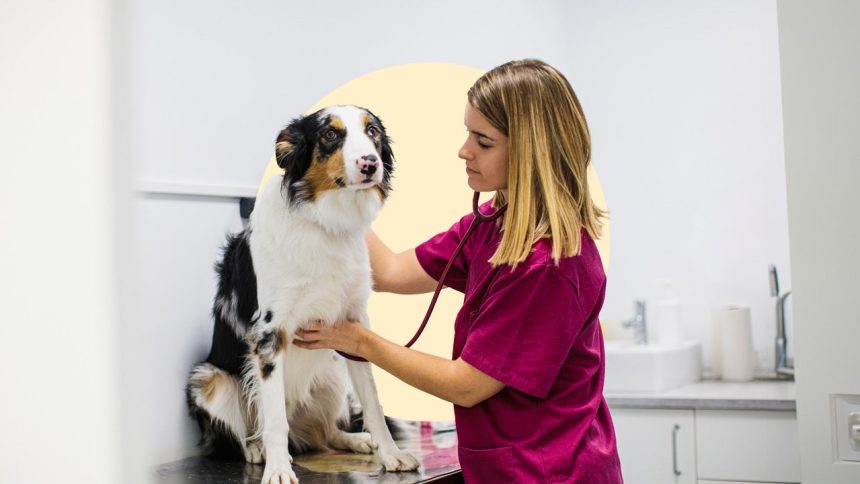Key takeaways
- Most pet insurance operates on a reimbursement model. You pay your vet up front and then file a claim for reimbursement from your insurance provider.
- Different insurers use percentage-based reimbursement, benefit schedules or actual cost reimbursement models.
- Knowing the specifics of your policy, including deductibles and reimbursement rates, is crucial for effective cost management.
- Carefully review your policy’s terms to understand what is covered and what is not, including exclusions and limitations.
When choosing pet insurance, understanding how reimbursements work is crucial for managing your pet’s healthcare costs effectively. Unlike human health insurance, which often involves direct billing and network restrictions, pet insurance typically follows a reimbursement model. This means you pay your veterinary bill up front and then submit a claim to your insurer to receive a portion of the costs back.
While this system offers flexibility by allowing you to visit any licensed veterinarian, it also requires careful budgeting and planning to cover expenses before reimbursement.
How pet insurance reimbursements work
The pet insurance reimbursement model requires pet owners to pay their vet bills up front and then file a claim to their insurance provider to receive compensation for a portion of those costs.
This system gives pet owners the freedom to choose any licensed veterinarian, specialist or emergency clinic, unlike human health insurance, which typically has network restrictions. However, it also means handling upfront payments and navigating the reimbursement process.
Why pet insurance uses a reimbursement model
Most of the best pet insurance companies use the reimbursement model for several reasons:
- Claims reductions: The reimbursement model transfers some financial responsibility to the pet owner. When pet owners must pay out of pocket before being reimbursed, they will probably consider whether treatment is necessary. This reduces the number of claims insurers need to process.
- Flexibility: One of the main reasons is the freedom it offers pet owners. This flexibility is crucial in emergencies where getting to the nearest available vet is more important than checking whether they are in-network.
- Less financial risk for insurers: By having pet owners pay for vet services up front, insurers minimize the risk of overpayment or fraud.
- Simple claims process: This model also simplifies the claims process. The insurer only reviews the submitted invoice and compares it to the policyholder’s coverage limits and terms.
- Streamlined billing process: The reimbursement model keeps things simple for vet clinics. They bill their clients and don’t have to worry about billing the many diverse insurance companies with their different structures and constraints.
- Lower premiums: Avoiding the administration and logistics of direct payment relationships with the thousands of veterinary clinics in the U.S. means that insurance providers can keep their premiums more affordable for pet parents.
Common reimbursement methods
Just as there are three types of pet insurance, there are also three main reimbursement methods commonly used by pet health insurance companies. Understanding the pros and cons of each can help you decide which reimbursement method aligns best with your financial situation and your pet’s healthcare needs.
Percentage-based reimbursement
This is the most common reimbursement method. Under this model, the insurer reimburses a fixed percentage (usually between 70 percent and 90 percent) of the total veterinary bill after you have met your deductible.
For example, if your policy covers 80 percent of vet costs, you’ve already met your deductible, and your bill is $1,000, you would be reimbursed $800. This method is straightforward, making it a popular choice among pet owners.
Pros
- Common across most pet insurance policies.
- Offers a balance between coverage and cost.
- Predictable and easy to calculate.
Cons
- Out-of-pocket expenses can be significant, especially with high vet bills.
- Pet owners may still need to cover a substantial portion of the cost.
Benefit schedules
Some insurers reimburse according to a benefit schedule. A benefit schedule lists health conditions and treatments with the maximum amount your insurance company will pay if your furry friend requires that treatment.
For instance, if your policy’s benefit schedule allocates $500 for a specific surgery, but the surgery costs $700, you would only receive a refund of $500. While this method provides clarity on the amount reimbursed, it can lead to higher out-of-pocket expenses if the actual costs exceed the scheduled benefits.
Pros
- Can be cost-effective if your vet costs align with the schedule.
- Clear, predefined reimbursement amounts for specific treatments.
- Easier to understand what you will be reimbursed for.
Cons
- Potential for significant out-of-pocket expenses if actual costs exceed scheduled benefits.
- May not fully cover more expensive or specialized treatments.
Actual cost reimbursement
Less common but still available from some insurers, this method reimburses the full cost of the treatment after deducting any copays and deductibles, provided the policy covers the treatment. This method offers the highest level of coverage but often comes with higher premiums.
For example, if your pet undergoes a $2,000 surgery, and you have a $200 deductible and a 10 percent copay, you will pay $400 out of pocket, and the insurer will reimburse you the remaining $1,600.
Pros
- Ideal for high-cost treatments and surgeries.
- Offers the highest level of coverage.
- Potential to cover the entire cost of treatment after deductibles and copays.
Cons
- Higher premiums compared to other reimbursement methods.
- Limited availability among pet insurance providers.
How to manage pet insurance reimbursements
Handling the reimbursement process effectively requires careful planning and attention to detail.
1. Know your policy
The first step in managing reimbursements is thoroughly understanding your policy. This includes knowing your deductible, copay and reimbursement percentage.
Get familiar with any exclusions or limitations in your policy, such as breed-specific issues or pre-existing conditions that could affect your reimbursement.
2. Keep detailed records
Accurate record-keeping is important for the reimbursement process. Keep copies of all veterinary invoices, receipts and related documentation. You’ll need to submit these records to your insurer when filing a claim. You may also need them should you want to dispute a rejected claim.
3. Explore payment plans
If your vet offers payment plans, consider using them for larger vet bills. Payment plans can help you manage the cost of expensive procedures until your insurance provider processes your reimbursement. However, ensure that the payment plan’s terms won’t cost you too much in fees and interest.
4. Have an emergency fund
An emergency fund for your pet’s medical expenses can be a lifesaver. This fund can cover vet bills while you wait for your reimbursement, ensuring your pet gets prompt, necessary care.
5. Submit claims promptly
To avoid delays in reimbursement, submit your claims as soon as possible after receiving veterinary care. Many insurers offer online portals or mobile apps that make the submission process quick and easy.
6. Communicate with your insurer
If you have any questions or concerns about your coverage or a specific claim, reach out to your insurer or broker. Clear communication can prevent misunderstandings and ensure you receive the reimbursement you’re entitled to.
Additional tips for managing costs
In addition to the strategies mentioned above, here are some extra tips for managing your pet’s healthcare costs under a reimbursement model:
- Ask for a pre-treatment estimate: Before agreeing to any expensive procedures, ask your vet for a detailed estimate of the costs. This can help you plan your finances and avoid surprises when it’s time to pay the bill.
- Consider direct vet pay options: Some pet insurance providers offer a direct vet pay option, where the insurer pays the vet directly, reducing your upfront costs. Check with your provider to see if this option is available and if your vet accepts it.
- Negotiate fees: In some cases, veterinarians may be willing to negotiate their fees, especially for high-cost treatments. It never hurts to ask if there’s any flexibility in the pricing, particularly if you’re a long-term client.
- Shop around for vets: Veterinary costs can vary significantly among clinics. Shop around for a vet who offers quality care at a reasonable price. Just be sure that you choose a licensed vet that meets your insurance provider’s requirements.
The bottom line
Understanding pet insurance reimbursement methods is essential for making informed decisions about your pet’s healthcare. The reimbursement model gives pet owners flexibility in choosing veterinarians. However, it requires you to pay vet bills up front and navigate the claims process.
Each reimbursement method has advantages and drawbacks. By knowing how these methods work, you can select a policy that best aligns with your financial situation and your pet’s needs. To ensure a smooth reimbursement experience, remember to review your policy details, keep thorough records and submit claims promptly.
If you’re currently shopping for pet insurance, your next step should be to compare policies from the top pet insurance companies. Pay close attention to reimbursement options, coverage limits and exclusions. If you already have a policy, review your terms and ensure you’re prepared for future claims. By staying informed, you can confidently manage your pet’s medical expenses and provide them with the best possible care.
Frequently asked questions
Read the full article here














